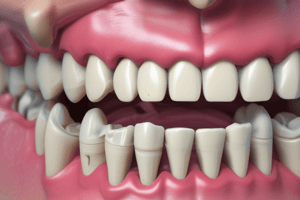Podcast
Questions and Answers
What is the main function of the periodontal ligament?
What is the main function of the periodontal ligament?
- To innervate the surrounding bone
- To produce dentin
- To develop the dental follicle
- To support the tooth in the socket (correct)
What type of collagen fibers are found in the periodontal ligament?
What type of collagen fibers are found in the periodontal ligament?
- Type IV and VI
- Type VII and VIII
- Type I and III (correct)
- Type II and V
Which of the following cells is NOT found in the periodontal ligament?
Which of the following cells is NOT found in the periodontal ligament?
- Fibroblasts
- Osteoclasts
- Osteoblasts
- Chondrocytes (correct)
During which stage of tooth development does the periodontal ligament form?
During which stage of tooth development does the periodontal ligament form?
What is a consequence of periodontal disease on the periodontal ligament?
What is a consequence of periodontal disease on the periodontal ligament?
What is the role of the periodontal ligament in orthodontic treatment?
What is the role of the periodontal ligament in orthodontic treatment?
What is the significance of the periodontal ligament in prosthodontic treatment?
What is the significance of the periodontal ligament in prosthodontic treatment?
What is the role of the periodontal ligament in periodontal therapy?
What is the role of the periodontal ligament in periodontal therapy?
Flashcards are hidden until you start studying
Study Notes
Structure and Function
- The periodontal ligament (PDL) is a group of specialized connective tissue fibers that attach the tooth to the surrounding bone.
- It is composed of:
- Principally collagen type I and III fibers
- Fibroblasts, osteoblasts, and osteoclasts
- Blood vessels and nerve endings
- The PDL is responsible for:
- Supporting the tooth in the socket
- Maintaining the position and alignment of the tooth
- Transferring occlusal forces to the surrounding bone
- Regulating tooth movement during orthodontic treatment
Development and Formation
- The PDL develops from the dental follicle, a group of cells surrounding the developing tooth
- During tooth eruption, the dental follicle differentiates into the PDL and the surrounding bone
- The PDL fibers mature and become functional as the tooth reaches its final position in the socket
Functions in Health and Disease
- In healthy conditions, the PDL maintains a balance between tooth movement and stability
- In periodontal disease, the PDL is affected by inflammation, leading to:
- Destruction of collagen fibers
- Loss of attachment between the tooth and bone
- Increased tooth mobility
- The PDL plays a crucial role in the repair and regeneration of periodontal tissues during periodontal therapy
Clinical Relevance
- The PDL is an important consideration in:
- Orthodontic treatment: the PDL's ability to adapt to changes in tooth position affects treatment outcomes
- Prosthodontic treatment: the PDL's attachment to the surrounding bone influences the stability of dental implants
- Periodontal therapy: the PDL's response to treatment affects the success of periodontal regeneration and repair
Structure and Function
- Periodontal Ligament (PDL) attaches tooth to surrounding bone, composed of collagen type I and III fibers, fibroblasts, osteoblasts, osteoclasts, blood vessels, and nerve endings.
- PDL supports tooth in socket, maintains position and alignment, transfers occlusal forces to surrounding bone, and regulates tooth movement during orthodontic treatment.
Development and Formation
- PDL develops from dental follicle, a group of cells surrounding the developing tooth.
- During tooth eruption, dental follicle differentiates into PDL and surrounding bone.
- PDL fibers mature and become functional as the tooth reaches its final position in the socket.
Functions in Health and Disease
- In healthy conditions, PDL maintains balance between tooth movement and stability.
- In periodontal disease, PDL is affected by inflammation, leading to destruction of collagen fibers, loss of attachment between tooth and bone, and increased tooth mobility.
- PDL plays a crucial role in repair and regeneration of periodontal tissues during periodontal therapy.
Clinical Relevance
- PDL is important in orthodontic treatment, as its ability to adapt to changes in tooth position affects treatment outcomes.
- PDL's attachment to surrounding bone influences stability of dental implants in prosthodontic treatment.
- PDL's response to treatment affects success of periodontal regeneration and repair in periodontal therapy.
Studying That Suits You
Use AI to generate personalized quizzes and flashcards to suit your learning preferences.




